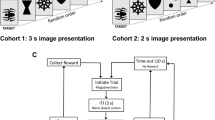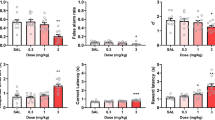Abstract
Flunitrazepam (1 and 2 mg), diazepam (10 and 20 mg) or placebo was administered to healthy, male volunteers, and the time course of psychomotor impairment, as indicated by simple and complex choice reaction time and movement time, was studied during a period of 6 h after drug intake. To examine whether acute tolerance developed, the observed performance during decreasing drug plasma concentration was compared to the predicted performance based on kinetic-dynamic modelling of the observed performance during the first 1.5 h after intake when the drug plasma concentrations were increasing or at peak level. Placebo corrections of the test scores were accomplished to adjust for diurnal variation and the possible influence of learning during the test day. After the flunitrazepam treatments, the predictions overestimated the actual performance significantly with respect to simple and choice reaction time at the 6-h session after intake. After the diazepam treatments, however, no significant deviation was detected between predicted and observed performance. The results indicate that acute tolerance develops with respect to impairment of attention demanding performance after medium to large doses of flunitrazepam, and that tolerance is expressed after approximately 4–6 h following intake.
Similar content being viewed by others
References
Arendt RM, Greenblatt DJ, deJong RH, Bonin JD, Abernethy DR, Ehrenberg BL, Giles HG, Sellers EM, Shader RI (1983) In vitro correlates of benzodiazepine cerebrospinal fluid uptake, pharmacodynamic action and peripheral distribution. J Pharmacol Exp Ther 227:98–106
Arendt RM, Greenblatt DJ, Liebisch DC, Luu MD, Paul SM (1987) Determinants of benzodiazepine brain uptake: lipophilicity versus binding affinity. Psychopharmacology 93:72–76
Braestrup C, Squires RF (1978) Pharmacological characterization of benzodiazepine receptors in the brain. Eur J Pharmacol 48:263–270
Campell DB (1990) The use of kinetic-dynamic interactions in the evaluation of drugs. Psychopharmacology 100:433–450
Colburn WA, Jack ML (1987) Relationships between CSF drug concentrations, receptor binding characteristics, and pharmacokinetic and pharmacodynamic properties of selected 1,4-substituted benzodiazepines. Clin Pharmacokinet 13:179–190
Ellinwood EH, Linnoila M, Easler ME, Molter DW (1983) Profile of acute tolerance to three sedative anxiolytics. Psychopharmacology 79:137–141
Ellinwood EH, Nikaido AM, Heatherly DG, Bjornsson TD (1987) Benzodiazepine pharmacodynamics: evidence for biophase rate limiting mechanisms. Psychopharmacology 91:168–174
Friedman H, Greenblatt DJ, Peters GR, Metzler CM, Charlton MD, Harmatz JS, Antal EJ, Sanborn EC, Francom SF (1992) Pharmacokinetics and pharmacodynamics of oral diazepam: effect of dose, plasma concentration, and time. Clin Pharmacol Ther 52:139–150
Frith CD, Done DJ (1986) Routes to action in reaction time tasks. Psychol Res 48:169–177
George KA, Dundee JW (1977) Relative amnesic actions of diazepam, flunitrazepam and lorazepam in man. Br J Clin Pharmacol 4:45–50
Greenblatt DJ, Sethy VH (1990) Benzodiazepine concentrations in brain directly reflect receptor occupancy: studies of diazepam, lorazepam and oxazepam. Psychopharmacology 102:373–378
Greenblatt DJ, Woo E, Alen MD, Orsulak PJ, Shader RI (1978) Rapid recovery from massive diazepam overdose. JAMA 240:1872–1874
Holford NHG, Sheiner LB (1981) Understanding the dose-effect relationship. Clin Pharmacokinet 6:429–459
Ingum J, Bjørklund R, Bjørneboe A, Christophersen AS, Dahlin E, Mørland J (1992) Relationship between drug plasma concentrations and psychomotor performance after single doses of ethanol and benzodiazepines. Psychopharmacology 107:11–17
Knutsen H, Dolva LB, Skrede SS, Bjørklund R, Mørland J (1989) Thyrotropin-releasing hormone antagonism of ethanol inebriation. Alcohol Clin Exp Res 13:365–370
Lê AD, Kalant H (1992) Influence of intoxicated practice on the development of acute tolerance to the motor impairment effect of ethanol. Psychopharmacology 106:572–776
Mandema JW, Sansom LN, Dios-Vièitez MC, Hollander-Jansen M, Danhof M (1991a) Pharmacokinetic-pharmacodynamic modeling of the electroencephalographic effects of benzodiazepines. Correlation with receptor binding and anticonvulsant activity. J Pharmacol Exp Ther 257:472–478
Mandema JW, Tukker E, Danhof M (1991b) Pharmacokinetic-pharmacodynamic modelling of the EEG effects of midazolam in individual rats: influence of rate and route of administration. Br J Pharmacol 102:663–668
Matthews JNS, Altman DG, Campbell MJ, Royston P (1990) Analysis of serial measurements in medical research. BMJ 300:230–235
Möhler H, Okada T (1977) Benzodiazepine receptor: demonstration in the central nervous system. Science 198:849–851
Palva ES, Linnoila M (1978) Effects of active metabolites of chlordiazepoxide and diazepam, alone or in combination with alcohol, on psychomotor skills related to driving. Eur J Clin Pharmacol 13:345–350
Wong PTH, Yoong YL, Gwee MCE (1986) Acute tolerance to diazepam induced by benzodiazepines. Clin Exp Pharmacol Physiol 13:1–8
Author information
Authors and Affiliations
Rights and permissions
About this article
Cite this article
Ingum, J., Bjørklund, R., Volden, R. et al. Development of acute tolerance after oral doses of diazepam and flunitrazepam. Psychopharmacology 113, 304–310 (1994). https://doi.org/10.1007/BF02245201
Received:
Revised:
Issue Date:
DOI: https://doi.org/10.1007/BF02245201




